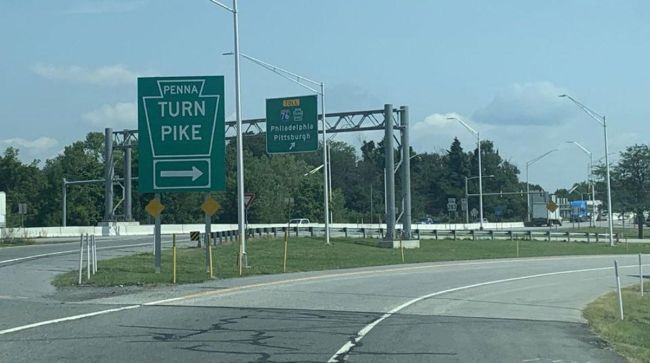The Pennsylvania Turnpike opened in 1940 as the nation’s first superhighway. (Jan Murphy/Tribune News Service)
Truckers traveling along the Pennsylvania Turnpike will notice some big changes, from modernized tolling infrastructure without toll plazas or booths and new fee structures starting in 2025.
Work is taking place on the turnpike, which opened in 1940 as the nation’s first superhighway, to convert its 550-mile statewide road system to a cashless, free-flowing toll-collection system called open-road tolling.
The new system involves charging tolls electronically to drivers traveling the turnpike without slowing down or stopping beneath new overhead steel gantries located between interchanges. Gantry equipment will classify vehicles and electronically process tolls.
“Open-road tolling will begin in 2025 in the eastern part of the state, specifically, east of Reading and on the Northeastern Extension. It will expand to the western region of the Pennsylvania Turnpike beginning in late 2026,” Carl DeFebo, turnpike commission director of communications and customer experience, told Transport Topics.

DeFebo said a big difference will be toll-collection points that shift from interchanges to gantry locations along the highway between exits on the eastern third of the turnpike system beginning in 2025.
“The plan for the Pennsylvania Turnpike has always been to move collection points away from our interchanges once the gantries were installed along the mainline of the roadway,” he said.
Another change is the new system will allow the new access points to be added more easily and at a lower cost by reducing traffic at interchanges and on connecting roads.
“Truckers have already mentioned they will see a savings on gas and be able to get where they are going more safely and faster,” DeFebo said.
He noted that open-road tolling will provide more convenience and better safety for drivers and turnpike employees.
“ORT is safer for drivers at entry/exit points, eliminating the confusion and lane switching associated with traditional, stop-and-go tolling,” he said. “Toll plazas can create unsafe conditions such as weaving and lane changing, erratic speeds to get from one side of the toll plaza to another and distracted drivers fumbling for change or toll tickets.”
The tolling system will also change from today’s nine weight-based vehicle classifications to a new one using a vehicle height/axle system with 11 different vehicle combinations. The 2025 open-tolling rates will be set in mid-2024.
DeFebo noted than more than 85% of turnpike customers already have an E-ZPass account, which points to “a clear preference for electronic payments.” Last year, 35.2 million commercial vehicles passed through the Pennsylvania Turnpike, up 5.3% compared to 2021. Truck traffic has increased steadily over the last several years.
This year, drivers passing through the eastern part of the turnpike’s mainline and Northeastern Extension will see toll equipment buildings and gantries being built starting on Interstate 76 at milepost 290.7 in Lancaster County, moving east to I-276 at milepost 348.7 in Bucks County, and then along the Northeastern Extension on I-476 starting at milepost A27.4 in Montgomery County up to milepost A123.4 in Lackawanna County, DeFebo said.

The overall 18-year project cost that began in 2011 to convert to all-electronic tolling, of which open-road tolling is the final phase, is expected to be $640 million. Project costs include demolishing tollbooths and related facilities as well as reconfiguring turnpike traffic patterns when the traditional toll facilities are removed by 2028 or 2029.
The project is being funded with toll revenue as part of the commission’s 10-year capital plan. Once complete, open-road tolling is projected to save the turnpike $75 million a year, including $50 million in yearly operational savings (partially through the elimination of nearly 500 toll collectors).
“It is important to weigh the overall project cost against the savings and value this significant investment delivers for the Commonwealth of Pennsylvania,” DeFebo said. “The commission anticipates $25 million yearly savings in interchange maintenance and operations once ORT is fully implemented — savings realized because we no longer need to spend hundreds of millions of dollars renovating and rebuilding more than 80 aging toll-plaza facilities.”
He said several municipalities have requested new open-road tolling access points on the turnpike be built, including in Montgomery County (Lafayette Street), Lackawanna County (Scranton Beltway) and Westmoreland County (Pennsylvania Route 130).
“The All-Electronic Tolling transition started more than 10 years ago. It has been implemented in phases to ensure a seamless conversion from our hybrid cash and E-ZPass system to our current AET system, and ultimately moving to our open-road tolling system,” said DeFebo. “Now more than ever, tolling facilities around the globe are implementing cashless operations. We’re seeing its benefits in safety, mobility, sustainability and environmental, just to name a few.”






